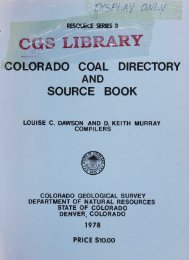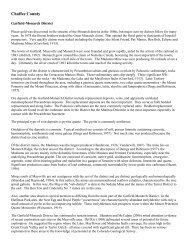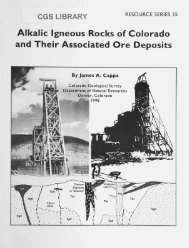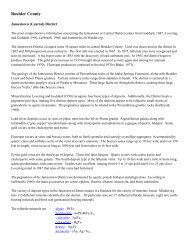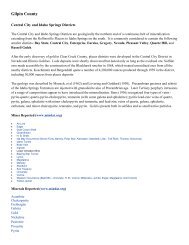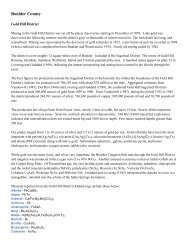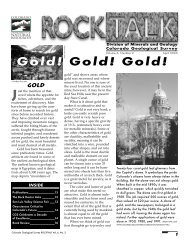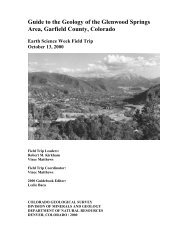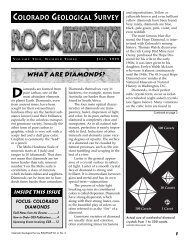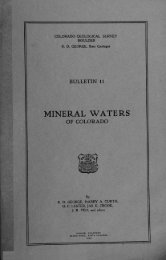Marble - Colorado Geological Survey
Marble - Colorado Geological Survey
Marble - Colorado Geological Survey
Create successful ePaper yourself
Turn your PDF publications into a flip-book with our unique Google optimized e-Paper software.
Textbook, Economic Evaluation and Investment<br />
Decision Methods, Sixth Ed. 1987, by Franklin<br />
J. and John M. Stermole.<br />
A rough rule of thumb used by quarry valuation<br />
experts according to Duncan Ogden is $.10<br />
per cubic foot multiplied times the volume of<br />
recovered, fullsized mill blocks. For this project<br />
that would amount to: $.10 times 20 percent<br />
recovery times 34,820,000 cubic feet equals<br />
$696,400<br />
Discounted Cash Flow<br />
The Discounted Cash Flow (DCF) used in this<br />
evaluation assumes several different manifestations<br />
of production for four, five, and six<br />
months of operation. These include three iterations<br />
of production with tolling of the tiles by<br />
an outside contractor, one six minth production<br />
withthe inclusion of a tile line, and one iteration<br />
of production with the assumption that<br />
whole blocks only would be sold to fabrication<br />
contractors for final disposition. At Conundrum<br />
Creek some have significantly longer periods of<br />
temperatures above freezing allowing longer<br />
operation of water utilizing equipment.<br />
The Discount Factor<br />
The discount factor (DCF) utilized in this study<br />
re-flects the corporate rate of return and the<br />
individual rate of return. The corporate rate of<br />
return used by CGS is that rate which a<br />
conservative corporation must have to offset<br />
cost of money, competing investments, and risk.<br />
The corporate rate is assumed to be 18 percent.<br />
This study is extremely sensitive to the discount<br />
factor, a percentage either way makes a<br />
difference of hundreds of thousands of dollars.<br />
Costs and Revenues<br />
The costs and revenues used by CGS have come<br />
from the experts mentioned above and are subject<br />
to a wide range of interpretation. For this<br />
study CGS assumed that costs would fall under<br />
the following categories: Development, the<br />
building of a staging area, improving roads, and<br />
site preparation. Quarrying, which includes<br />
transportation. Fabrication, the processing of<br />
blocks into finished slabs, of broken blocks to<br />
tile planks, and sawing and guillotining waste<br />
into ashlar veneer strips.<br />
The cost and revenues per product are summarized<br />
below. Quarrying costs are assumed at<br />
$6.00 per cubic foot of usable marble. Any block<br />
that is quarried has this cost which includes direct<br />
labor, haulage to the fabrication facility assuming<br />
that it is reasonably close, and indirect<br />
cost such as overhead. Fabrication costs for<br />
slabs of 5.5 feet by seven feet are approximately<br />
$175 per slab. This figure includes the $6.00 per<br />
cubic foot as well as overhead and direct labor.<br />
Capital costs include quarrying equipment,<br />
fabrication equipment, and a building to house<br />
the fabrication equipment. Land for this building<br />
is assumed to be located near Basalt, <strong>Colorado</strong>,<br />
where there appears to be opportunity for<br />
an eight acre site of this nature. CGS contacted<br />
the Eagle County Assessor's Office for the cost<br />
of such a site and found it to be $5,000 per acre.<br />
The product line for this operation includes<br />
slabs cut from large quarry blocks. These slabs<br />
are roughly 5.5 feet in width by seven feet to<br />
eight feet in length and could vary in thickness<br />
but are assumed here to be .75 inch. The large<br />
quarry blocks of these dimensions weigh between<br />
18.5 and 20 tons and have a volume of<br />
over 200 cubic feet. The slabs which can be cut<br />
from these blocks are worth between $8.00 and<br />
$15.00 per square foot. CGS assumed $9.00<br />
because the material would be on the low side<br />
of the market. A quote from a buyer yielded a<br />
similar number. CGS also assumed that there<br />
would be loss in slab cutting due to breakage,<br />
imperfections in color or quality, or inclusions<br />
of chert or pyrite. Production from the blocks<br />
would be 56 slabs. This 85 percent recovery is<br />
considered low by industry standards but is<br />
justified by the materials tests which place the<br />
marble in the lower spectrum of allowable<br />
strengths. The set up of the fabricating plant is<br />
directed toward producing these polished slabs<br />
which could in small part be custom fabricated<br />
into sink and counter tops but more likely will<br />
be sold to distributors These distributors expect<br />
a 100 percent markup to the contractor.<br />
The second product expected from this operation<br />
is 12 inches square by .375 inch thick<br />
33



